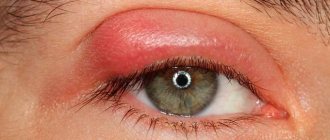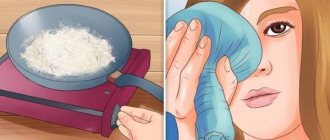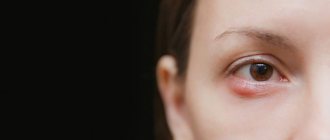Stye on the eye is not a serious disease, but it can create significant discomfort. The condition when the stye itches, hurts, and (albeit minor but unpleasant) discharge appears, to some extent, limits a person in his daily activities. The good news is that eye styes and the itching associated with them are easily treatable.
What is barley
Stye (also known as hordeolum) is a common, non-fatal infection of the eyelid and is one of the most common eyelid diseases. A stye on the eye is an inflammation of the sebaceous gland of one of the eyelashes (Zeiss gland). These glands are located at the edges of the eyelids and protect eyelashes from fragility.
The sebaceous glands of the eyelashes are very small; under normal circumstances, their job is to moisturize the eyelashes. However, if for some reason the gland becomes inflamed, it becomes clogged with sebum and increases in size. Bacteria begin to multiply inside the inflamed gland, which can lead to the accumulation of pus. A painful hardening appears on the upper or lower eyelid, which can reach the size of a mature grain of barley (hence the name of the disease), hurt and itch.
What to do if the stye is very itchy -
A lot of troubles are associated with a swollen eye on the face. In addition to the negative emotions from an aesthetically inadequate appearance associated with swelling and redness of the eye, it is quite unpleasant to experience interference with vision, a narrowing of the viewing angle, and even pain. Such sensations are characteristic of a disease such as eye stye.
Why does stye occur?
The occurrence of stye is an inflammation of the hair follicle of the eyelash. Initially, there is swelling and redness, which after a few days transforms into an abscess.
After “ripening” it ruptures with the release of pus.
As a rule, relapses of this disease are quite rare, but under some circumstances related to the individual characteristics of the body and hygienic conditions, barley can bother a person quite often.
The nature of the occurrence of barley is mainly infectious. Bacterial staphylococcus is most often to blame for the unexpected appearance of discomfort on the eye.
A weakened body, chronic diseases, hormonal imbalance, hypothermia or simply prolonged malaise, which undermine a person’s defense mechanisms, contribute to the appearance of various pathologies, including barley.
Diseases of the gastrointestinal tract (GIT), diabetes, tuberculosis, allergies or infection with worms can cause the periodic appearance of barley throughout the year.
External manifestations (symptoms)
When the eye comes into contact with dirty water, unwashed hands or poor-quality cosmetics, or even if the eyes were not washed after getting in with dust, a slight itching of the eyelid is observed.
Redness and swelling soon appear. Subsequently, an abscess forms.
In addition to discomfort, the process of “ripening” barley is accompanied by pain, in some cases with fever and headache.
Unlike stye on the outside of the eyelid, there is a so-called internal stye, in which the sebaceous glands inside the eyelid become inflamed. Usually the process begins with the sensation of a foreign body in the eye and when examined from the outside, almost nothing is visible. Only by turning out the eyelid can you notice some new formation - an internal stye on the eye.
Regardless of the location of the stye on the upper or lower eyelid, it is located on the edge of the eyelid, which does not lead to inflammation of the entire eye.
Why does stye itch on the eye?
Today it is known that itching and pain are different in intensity effects on the nerve endings at the site of pathology.
According to some data, irritation in places where itching is localized is accompanied by the presence of a large amount of histamine, which can cause the stye on the eye to itch.
Itching is assumed to be the first warning of pathology and the possible occurrence of pain.
With barley, as with other irritations, a protective reaction occurs - inflammation, accompanied by suppuration. Purulent exudate will contain many purulent bodies that create a tumor at the location of the stye.
A red eyelid is an inflammation of the skin. The appearance of skin irritation from the development of the suppuration process is manifested by the redness of the area of skin inflammation - one of the symptoms of a developing neoplasm - barley.
Treatment of barley
The appearance of symptoms indicating a pathology that may be associated with the occurrence of barley, namely itching, redness, swelling, the sensation of a foreign body in the eye, causes the patient to take action to relieve these phenomena. In children and even some adults, the first reaction is to scratch. In the case of barley, this does not solve the problem.
It is necessary to correctly diagnose the disease and take timely measures for treatment.
What to do if stye on the eye itches
In the case of a mild form of external stye on the eyelid, you can cope with the disease on your own.
In this case, the use of folk remedies or careful treatment of the swelling (pustule) with 70% alcohol leads to the disappearance of unpleasant sensations within a week or even in 2-3 days.
However, if the site of inflammation of the eyelid hurts severely and does not calm down for several days, then it is better to consult a specialist to diagnose and take radical measures to treat the tumor.
Features of treatment
When symptoms characteristic of styes appear on the eyelid, it is necessary to separate this neoplasm from similar diseases and, first of all, from chalazion and blepharitis. Both the symptoms and causes of these diseases are largely the same, however, chalazion is chronic and can be the result of untimely treatment of barley. It is also necessary to exclude conjunctivitis.
Since barley is usually a bacterial disease, its etiological treatment is based on the use of antibiotics. They destroy bacteria and prevent them from developing in the body. Also, in addition to taking antibiotics, probiotics are prescribed to protect the microflora. Before the abscess appears, it is possible to prescribe physiotherapeutic procedures - warming with a blue lamp or UHF.
Local therapeutic treatment is based on the use of ointments and drops containing antibacterial elements. Often local therapy successfully copes with ordinary barley.
Treatment is medicinal
Since barley is an infectious disease of a bacterial nature, such treatment involves the use of medications that have antibacterial properties. Traditionally, eye drops, ointments, and antiseptic solutions are used for treatment.
The drugs used for drug treatment have antibacterial and anti-inflammatory properties and act on a wide range of pathogenic microorganisms.
Eye drops are a common treatment; 1-2 drops are instilled into the affected eye several times a day. Prescribed drops:
DropsApproximate price
| Albucid | from 17 rub. |
| Tsiprolet | from 100 rub. |
| Phloxal | from 250 rub. |
| Tobrex | from 170 rub. |
| Ciprofloxacin | from 23 rub. |
| Gentamicin | from 150 rub. |
Eye ointments are highly effective drugs in the treatment of barley and are also often recommended for use. Ointments are used by placing a small amount under the eyelid that is affected by stye. Use ointments:
OintmentApproximate price:
| Tetracycline | from 20 rub. |
| Hydrocortisone | from 20 rub. |
| Phloxal | from 150 rub. |
| Erythromycin | from 50 rub. |
Alcohol solutions - it is recommended to use such preparations as 70% alcohol, brilliant green and iodine.
Apply a small amount of solution to the stye site with a cotton swab, carefully so that it does not get into the eye on the mucous membrane.
The specific treatment regimen depends on the severity of the disease and the patient's condition. To speed up the treatment process and achieve maximum treatment effect, the doctor uses an integrated approach - a combination of various drugs - ointments and drops, prescribing, in some cases, antibiotics in the form of tablets for oral administration. If necessary, the abscess is opened surgically.
Folk remedies
Along with medications, folk remedies are used to treat stye, which help alleviate the condition, reduce and relieve redness of the eyelid, swelling, itching, pain, localize inflammation, and eliminate infection.
At the initial stage of the disease, until suppuration has formed and only redness is observed, dry heating can be used to speed up the process - the abscess will mature faster and, therefore, will go away faster. As a heat source, you can use cloth bags filled with salt heated in a frying pan. The bags are placed on the affected eye and kept until they cool down.
Medicinal plants with antimicrobial properties are widely used in treatment, such as:
- Birch buds;
- aloe leaves;
- plantain;
- eyebright;
- chamomile flowers;
- calendula.
Infusions are prepared from them and used in the form of lotions several times a day. Typically, 1-3 tablespoons of dry plants are poured into 200-250 mm of boiling water and left for 30 minutes, then filtered and cooled. It is better to use freshly prepared infusion; at least it should not be stored (in the refrigerator) for more than a day.
On the use of folk remedies, it is advisable to consult a doctor and receive his professional recommendations, depending on the course of the disease and the medications used.
Prevention
The main principle of preventing eye diseases, especially infectious ones, is the rule - first of all, maintain personal hygiene. Do not touch your face and eyes with dirty hands, use only your personal hygiene items (face towel, handkerchief) and accessories for applying cosmetics to your eyelids.
Since barley often occurs against the background of existing diseases and weakened immunity, it is necessary to diagnose and treat the underlying disease and take measures to maintain and strengthen the immunity of the entire body.
When stye appears on the eye and until the end of its treatment, it is necessary to take preventive measures to prevent possible complications and the spread of infection to other elements of the eye, as well as to the second eye.
What not to do, especially after the appearance of pus, the contact of which with healthy neighboring tissues can cause unpleasant consequences and complications:
- touch and comb the stye with your hands;
- squeeze or pierce;
- warm up barley with a purulent head.
All treatment procedures should be carried out with clean hands, and hands should be washed both before and after procedures. Barley is not a very dangerous pathology, but, as with other diseases, prevention and timely treatment will avoid many troubles.
Video on the topic
Source: https://ProZyd.ru/golova/pochemu-cheshetsya-yachmeny-na-glazu.html
Causes
There are a number of reasons why stye may appear on the eye - from the most banal to the serious:
- incorrect or unsatisfactory compliance with sanitary and hygienic standards;
- incorrect use of decorative cosmetics and/or makeup removal;
- erroneous insertion of contact lenses and their use;
- touching the eyes with unwashed hands or dirty objects;
- staying in a dusty, polluted environment;
- weakening of the immune system;
- the presence of other diseases, such as diabetes, rosacea, inflammation of the lacrimal glands;
- eye-strain;
- lack of vitamins, etc.
Clinical picture
The onset of the disease is usually characterized by discomfort when a person feels pressure in the eye or its surroundings. There may be a sensation of the presence of a foreign body in the eye, which cannot be eliminated even by intense blinking. After this, a feeling of pain appears on the eyelid or around the eye, pain and burning in the eyes, painful perception of light.
Attention! Sometimes it is not the stye as such that itches, but the eyelid itself, where the inflammatory process has not yet begun, but the infection is already present. Itching is the first sign indicating the approach of the disease.
At first, stye on the eye manifests itself as swelling and redness of the entire affected eyelid, later – pain and redness of the skin, concentrated in one small place on the edge of the eyelid. Subsequently, a lump (tubercle) forms in this place, gradually filling with pus.
Other symptoms
At the beginning of the maturation of the hordeolum, a feeling of discomfort appears - the pressure in and around the organ of vision increases, and the presence of a foreign body may be felt in the eye. Then pain occurs on the eyelid and in the periocular area, the skin turns red, itches, burns, swelling, pain appears, and lighting is painful. After a while, a small tubercle appears in the affected area, gradually filling with pus. This is how barley is formed. There is a purulent yellow grain on the inside of the eyelid. The density of the fluid secreted by the lacrimal gland changes, and pressure on the eye increases, which can cause blurred vision.
If the infection is severe, the following symptoms may occur with a weakened immune system:
The disease can affect a person's appetite, causing it to worsen.
- increased body temperature;
- loss of appetite;
- increased tear production;
- headache;
- general weakness, malaise;
- nausea;
- an increase in the size of regional lymph nodes, usually in the cervical region.
If the disease is mild, the abscess bursts on its own after a few days, pus flows out of it and the hordeolum heals. But it is possible for the pathology to transition from the acute stage to the chronic stage, with the formation of a painless bulge on the eyelid. With this condition there is no swelling, pain or redness. The stye does not burst, may increase in size or quantity, and may also be recurrent.
With a more serious course of the disease, the abscess not only hurts and itches very much, but the following symptoms may also be observed:
- irritation of the organs of vision;
- spread of the inflammatory process throughout the entire eye;
- blurred vision.
Treatment
The basis of treatment is patience. The stye should ripen and then burst, releasing pus. After this, the stye on the eyelid will disappear. However, if the grain is very painful, very itchy, or persists for two weeks or longer, it is advisable to consult an ophthalmologist, who will cut the grain under sterile conditions (!), allowing the pus to drain. The incision is performed on an outpatient basis under local anesthesia (in children, general anesthesia is sometimes used due to the risk of injury if the head is jerked). In some cases, removal of the eyelashes is also recommended, which will make it easier for the contents of the stye to drain.
Attention! Accompanying unpleasant symptoms, such as itching or pain, sometimes cause a person to scratch or rub their eyes. But these actions increase the risk of further infection entering the eyes from unsterile hands.
Warm compresses can be used to relieve itching and speed up grain ripening. One option is a wet (preferably just wet) compress (for example, a handkerchief soaked in a hot chamomile decoction or boric water); Another option is dry warm compresses (for example, an ironed handkerchief).
Symptoms
The clinical picture of the disease begins to appear with slight discomfort in the eyelid area. It varies slightly depending on where the hordeolum develops (outside or inside the eyelid).
If the stye is external, then first a small pinkish swelling forms on the eyelid, which becomes painful over time. Gradually, the tubercle grows to the size of a mature barley grain and fills with pus. All this is accompanied by a constant desire to scratch the sore and squeeze it out, which is strictly prohibited due to the high risk of infection of the eye structures.
Hordeolum is not always located on the surface of the eyelid. It can develop on the inside of the eye due to infection of the meibomian glands, which are responsible for keeping the eyes moisturized.
Barley ripens very slowly and its healing process is painful. The person feels that the eyelid seems to swell, and the inside of the eye begins to scratch. There is a feeling of the presence of a foreign body in the eye, but upon examination the person cannot detect anything. Even with the help of blinking, it is impossible to get rid of such an uncomfortable symptom.
Gradually, as the stye develops, a pinkish swelling appears on the eyelid, the touch of which causes pain. If you turn the eyelid slightly outward, you can see a yellowish purulent “grain” from inside it.
Barley itching and Ofthalmo-Septonex
Ophthalmo-Septonex eye ointment has antiseptic properties and is therefore suitable for the treatment of benign purulent inflammation of the anterior segment of the eye.
The ointment reduces itching and pain.
Indications. Ophthalmo-Septonex is used in adults and children for inflammation of the eyelids and conjunctiva, damage to the cornea, after removal of foreign bodies and treatment of injuries. In case of severe, especially purulent inflammation, it is necessary to consult a doctor.
Contraindications. Hypersensitivity to the active substance or any of the other ingredients, as well as decreased tear production, inflammation of the cornea and conjunctiva with limited tear secretion.
Pregnancy and breastfeeding. During pregnancy and lactation, the product can be used in the short term after consultation with a doctor.
The drug has no effect on driving.
Why does stye itch on the eye and what does it mean?
Stye on the eye (hordeolum) is an inflammation of the sebaceous gland of one of the eye cilia. The glands are located at the edges of the eyelids. Their main task is to moisturize eyelashes and protect them from fragility and loss.
But if the gland becomes clogged with dirt or sebum, it becomes inflamed, increases in size, and pathogenic microorganisms develop inside it, causing the appearance of pus.
In this case, a hard, painful formation appears on the upper or lower eyelid, which grows and becomes similar to a large grain of barley (hence the name of the disease “barley”).
Causes
Stye is a common eyelid disease; almost every person encounters it in their life. Hordeolum causes significant discomfort to the person who has it - it hurts, itches, itches, and interferes with normal vision and blinking. Fortunately, such inflammation does not last long, and the unpleasant manifestations of barley can be stopped with medications and folk remedies.
There are a large number of reasons why stye appears on the eye. They can be mundane and serious.
The following factors most often provoke the development of inflammation of the eyelash follicle:
- touching eyelids and eyes with dirty hands;
- weakening of the body's defenses;
- long stay in an area with increased pollution (dust, chemicals);
- poor hygiene when using contact lenses and decorative cosmetics;
- inflammatory processes of the eye structures;
- avitaminosis.
Symptoms
The clinical picture of the disease begins to appear with slight discomfort in the eyelid area. It varies slightly depending on where the hordeolum develops (outside or inside the eyelid).
If the stye is external, then first a small pinkish swelling forms on the eyelid, which becomes painful over time. Gradually, the tubercle grows to the size of a mature barley grain and fills with pus. All this is accompanied by a constant desire to scratch the sore and squeeze it out, which is strictly prohibited due to the high risk of infection of the eye structures.
Hordeolum is not always located on the surface of the eyelid. It can develop on the inside of the eye due to infection of the meibomian glands, which are responsible for keeping the eyes moisturized.
Barley ripens very slowly and its healing process is painful. The person feels that the eyelid seems to swell, and the inside of the eye begins to scratch. There is a feeling of the presence of a foreign body in the eye, but upon examination the person cannot detect anything. Even with the help of blinking, it is impossible to get rid of such an uncomfortable symptom.
So why does stye itch?
Hordeolum is characterized by unbearable itching. It’s rare that anyone can resist scratching it at least lightly. Why does this happen and what does it mean?
Itching of a sore eyelid occurs for a number of reasons:
- Inflammation. Itching and pain are the first signs of inflammation. It is because of them that the stye itches. Inflammation is accompanied by the production of histamine (a biologically active substance), which leads to itching and the desire to scratch. But it is precisely when exposed to a large amount of histamine that the wound heals after the abscess breaks through. After the cessation of the inflammatory process and restoration of the skin, histamine levels return to normal, and the desire to itch disappears.
- Allergy. The desire to scratch the stye is provoked by medicinal drops and ointments, which can cause allergic reactions. In this case, you may notice small blisters, increasing redness around the stye, and swelling. After discontinuation of the drug, the itching decreases.
- Irritation of the conjunctiva . Barley often itches and develops on the inside. As it matures, it irritates the conjunctiva, causing a foreign body sensation. The natural reaction of a person is to get rid of the disturbing object by scratching the eye.
- Wound healing . The source of itching and the desire to scratch the sore spot is the growth of new cells and nerve endings during the wound healing period. This is another reason why stye on the eye itches. When the pus drains, the healing process begins, skin cells are restored and new nerve endings appear. They are very sensitive to any stimulus, so they send a signal to the brain at the slightest impact on them. Subjectively, a person perceives this as a slight itch or tickling, which is why one really wants to scratch the eyelid.
Drug treatment
To treat barley in the first stages, doctors advise warming up the sore with dry heat to speed up its maturation. As soon as the head of pus appears, the use of heat is prohibited.
Barley is by its nature a disease caused by bacteria, so the basis of its treatment is antibacterial drugs in the form of ointments and drops.
They inhibit the action of bacteria, stopping their growth, help cope with inflammation and reduce the risk of recurrence of hordeolum. Generally, broad-spectrum antibiotics are used to kill most pathogenic microorganisms.
Among the drops, Albuci d, Tobrex, Tsiprolet, Levomycetin are widely used. Instillations (instillations) are carried out 4 times a day.
In addition to drops, ointments with an antibacterial effect (hydrocortisone, tetracycline, erythromycin) are used. They are placed behind the eyelid at night if there is an internal stye or applied directly to the sore if the hordeolum is external, for at least 5 days, even if the symptoms disappear earlier.
In some cases, doctors use an integrated approach to treating barley, combining ointments, drops, and antibiotic tablets. At the same time, you should take vitamin complexes to strengthen your immune system.
Traditional methods of treatment
Barley is not a very serious disease, so if there are no complications, you can treat it at home using traditional medicine recipes.
Dry heating with river sand or salt
At the very beginning of the development of barley, when the purulent top has not yet appeared, you can warm the itchy area with heated dry river sand or salt placed in a cloth bag. You need to heat sand or salt to a temperature that is comfortable for the skin. Care must be taken that heating does not lead to burns. The bag is applied to the sore spot and held until it cools.
Calendula decoction
2 tablespoons of dried herb are poured with a glass of boiling water, left for 30-60 minutes, filtered. Apply the infusion in the form of compresses to the eyes, soaking cotton pads in it and applying them overnight, securing them with a bandage. Calendula has excellent anti-inflammatory properties, eliminating itching and skin irritation.
Healing lotions
For lotions, you can use any plant of your choice (aloe, eyebright, chamomile, plantain). All of them have antimicrobial and anti-inflammatory effects.
An infusion is prepared at the rate of 2-3 tablespoons of plant material per glass of boiling water. Pour, leave for 30-60 minutes, cool, filter.
Soak a gauze swab in the resulting medicinal infusion and apply it to the inflamed area several times a day for 10-15 minutes.
Complications
Barley, although not very serious, is quite an unpleasant disease. In a mild form, after a few days the hordeolum ripens, bursts, pus flows out, and the wound heals without a trace. But in some cases the disease becomes chronic.
Many people, especially children, cannot resist scratching or at least rubbing the painful lump. Sometimes this happens unconsciously in a dream. As a result, an infection occurs in the eye structures, and numerous complications appear.
The most common are:
After damage to the hordeolum, the risk of relapse increases; the stye takes much longer to heal, does not burst, but only grows, creating a large bulge on the eyelid. It does not swell, does not hurt, disappears for a while, and at the slightest weakening of the immune system appears again.
In particularly difficult cases, barley provokes decreased vision and the spread of inflammatory processes throughout the entire eye. Fortunately, this happens very rarely.
Prevention of stye
It is easier to prevent the appearance of gordeolum than to suffer for a whole week, enduring itching, pain, and aesthetic discomfort.
The rules of prevention are as follows:
- Touch your eyes with your hands as little as possible, especially on the street.
- If you have an allergy, which often provokes the appearance of barley, you should start taking antihistamines on time and avoid contact with allergens if possible.
- When swimming, protect your eyes from chlorinated water with special goggles.
- When using contact lenses, insert and remove them only with clean fingers, and store them in a liquid specially designed for this purpose. It is recommended to remove lenses at night.
- Use only your own personal hygiene items and cosmetics.
The rules are simple, but they will significantly reduce the risk of infection in the eye structures and eyelids.
Source: https://GlazaLik.ru/bolezni-glaz/yachmen/cheshetsya/
People's Councils
You can seek the help of some folk tips for treating stye. Classic and unsurprising methods involve applying the principle of a hot compress, enhancing their effect with the healing power of certain herbs.
Thus, one of the treatment options involves applying a cotton swab to the eye, soaked in a brine prepared from a handful of chopped parsley, poured with a glass of hot water. The infusion is used after 10 minutes of settling. It should be kept on the eye until it cools down.
Another home remedy for stye that relieves itching and soreness is to use green tea. Place a bag of unflavored green tea in boiling water, wait until it cools slightly, cover it with a blindfold and leave overnight.
Folk remedies
Along with medications, folk remedies are used to treat stye, which help alleviate the condition, reduce and relieve redness of the eyelid, swelling, itching, pain, localize inflammation, and eliminate infection.
At the initial stage of the disease, until suppuration has formed and only redness is observed, dry heating can be used to speed up the process - the abscess will mature faster and, therefore, will go away faster. As a heat source, you can use cloth bags filled with salt heated in a frying pan. The bags are placed on the affected eye and kept until they cool down.
Medicinal plants with antimicrobial properties are widely used in treatment, such as:
- Birch buds;
- aloe leaves;
- plantain;
- eyebright;
- chamomile flowers;
- calendula.
Infusions are prepared from them and used in the form of lotions several times a day. Typically, 1-3 tablespoons of dry plants are poured into 200-250 mm of boiling water and left for 30 minutes, then filtered and cooled. It is better to use freshly prepared infusion; at least it should not be stored (in the refrigerator) for more than a day.
On the use of folk remedies, it is advisable to consult a doctor and receive his professional recommendations, depending on the course of the disease and the medications used.
Complications of stye
The most common complications include the spread of infection (inflammation of the lacrimal gland, orbit of the eye), recurrence of stye, and prolonged ripening of stye.
Another complication of the disease is, in fact, another disease - we are talking about chalazion. These 2 ailments are often very different from each other. Styes and chalazions differ in the glands they affect (chalazions affect the deep glands); in addition, chalazion, unlike barley, is infectious in nature. This is a small, painless hardening, often chronic, and does not burst for a long time. Almost always you have to deal with medical intervention.











